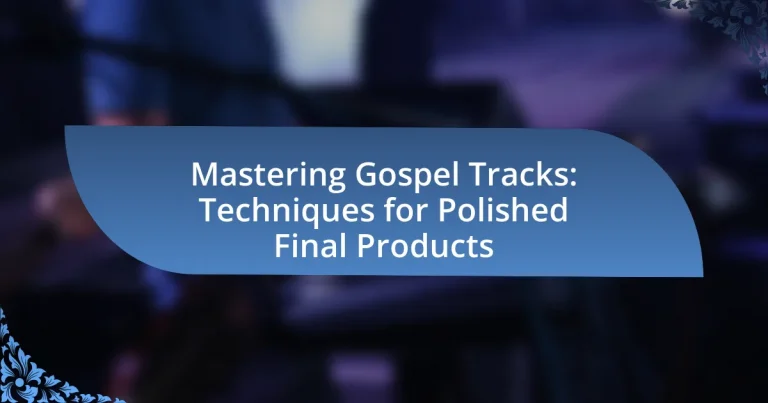Mastering gospel tracks involves applying key principles such as clarity, balance, and emotional impact to achieve a polished final product. This article outlines the differences between mixing and mastering, specific techniques used in mastering, and the importance of dynamic range in gospel music. It also addresses common mistakes to avoid, tools essential for mastering, and best practices for preparing tracks. Additionally, the article emphasizes the significance of stereo imaging and consistency across multiple tracks, providing practical tips and software recommendations for effective mastering in gospel music production.

What are the key principles of mastering gospel tracks?
The key principles of mastering gospel tracks include achieving clarity, balance, and emotional impact. Clarity ensures that each instrument and vocal is distinctly heard, which is crucial in gospel music where lyrics convey powerful messages. Balance involves adjusting levels so that no element overwhelms another, maintaining the integrity of the arrangement. Emotional impact is achieved through careful use of dynamics and effects, enhancing the spiritual experience for listeners. These principles are supported by industry standards, such as the use of equalization and compression techniques that are widely recognized for their effectiveness in producing polished audio.
How does mastering differ from mixing in gospel music?
Mastering and mixing in gospel music serve distinct purposes in the audio production process. Mixing involves combining individual audio tracks, adjusting levels, panning, and applying effects to create a cohesive sound, while mastering is the final step that prepares the mixed audio for distribution by optimizing overall volume, tonal balance, and ensuring consistency across playback systems.
In gospel music, mixing focuses on enhancing vocal clarity and blending instrumental elements to support the message, whereas mastering ensures that the final product meets industry standards for loudness and quality, often utilizing tools like equalization and compression to achieve a polished sound. This differentiation is crucial for delivering the emotional impact characteristic of gospel music.
What specific techniques are used in mastering gospel tracks?
Specific techniques used in mastering gospel tracks include equalization, compression, limiting, and stereo enhancement. Equalization adjusts frequency balance to ensure clarity and presence, particularly for vocals and instruments typical in gospel music. Compression controls dynamic range, making softer sounds more audible while preventing louder sounds from distorting, which is crucial for the emotional delivery in gospel tracks. Limiting is applied to maximize loudness without clipping, ensuring the track maintains its impact. Stereo enhancement techniques, such as widening the stereo field, create a fuller sound that is essential for the rich harmonies found in gospel music. These techniques collectively contribute to a polished final product that resonates with listeners.
Why is mastering important for the final sound quality of gospel music?
Mastering is crucial for the final sound quality of gospel music because it ensures that the audio is balanced, polished, and optimized for various playback systems. This process involves adjusting levels, equalization, compression, and limiting to enhance the overall sonic quality, making the music sound cohesive and professional. Mastering also addresses issues such as dynamic range and frequency balance, which are essential for the emotional impact of gospel music, as it often features rich harmonies and powerful vocals. By applying these techniques, mastering helps to create a final product that resonates well with listeners, ensuring that the spiritual message is conveyed effectively.
What role does dynamic range play in mastering gospel tracks?
Dynamic range is crucial in mastering gospel tracks as it enhances emotional impact and clarity. A well-managed dynamic range allows for the contrast between soft and loud passages, which is essential in gospel music to convey the genre’s emotional depth and spiritual messages. For instance, the use of dynamic range can highlight vocal performances, making them more expressive and engaging, while also ensuring that instrumental elements are balanced and clear. This balance is supported by the fact that gospel music often features powerful vocalists and rich instrumentation, where the dynamic range can significantly affect the listener’s experience.
How can dynamic range be effectively managed during the mastering process?
Dynamic range can be effectively managed during the mastering process by utilizing compression and limiting techniques. Compression reduces the volume of the loudest parts of a track while boosting quieter sections, resulting in a more balanced sound. Limiting further controls peaks to prevent distortion and maintain a consistent output level. According to the Audio Engineering Society, proper use of these tools can enhance the perceived loudness of a track without sacrificing dynamic expression, which is crucial in gospel music to convey emotional depth.
What tools are essential for controlling dynamic range in gospel music?
Essential tools for controlling dynamic range in gospel music include compressors, limiters, and equalizers. Compressors reduce the volume of loud sounds and amplify quieter ones, ensuring a balanced dynamic range. Limiters prevent audio signals from exceeding a certain threshold, protecting against distortion and clipping. Equalizers allow for frequency adjustments, enhancing clarity and presence in the mix. These tools are crucial in achieving a polished final product, as they help maintain the emotional impact and clarity characteristic of gospel music.
What are the common mistakes to avoid in mastering gospel tracks?
Common mistakes to avoid in mastering gospel tracks include neglecting dynamic range, over-compressing audio, and failing to maintain clarity in vocal elements. Neglecting dynamic range can lead to a flat sound, diminishing the emotional impact of the music, which is crucial in gospel. Over-compressing audio often results in a loss of warmth and naturalness, making the track sound lifeless. Additionally, failing to maintain clarity in vocal elements can obscure the message and emotional delivery, which are essential in gospel music. These mistakes can compromise the overall quality and effectiveness of the final product.
How can over-compression affect the quality of gospel music?
Over-compression can significantly degrade the quality of gospel music by reducing its dynamic range and emotional impact. When gospel tracks are excessively compressed, the natural variations in volume that convey emotion and intensity are flattened, leading to a lifeless sound. This is particularly detrimental in gospel music, where expressive vocal performances and instrumental dynamics are crucial for conveying spiritual messages. Studies have shown that music with a reduced dynamic range can lead to listener fatigue and diminished engagement, as the emotional highs and lows that characterize gospel music are lost.
What are the signs of poor mastering in gospel tracks?
Signs of poor mastering in gospel tracks include a lack of dynamic range, excessive compression, and imbalanced frequency response. When dynamic range is compromised, the emotional impact of the music diminishes, making it sound flat and lifeless. Excessive compression can lead to distortion and a loss of clarity, which is particularly detrimental in gospel music that relies on vocal expression. An imbalanced frequency response may result in certain instruments or vocals being overly prominent or buried in the mix, disrupting the overall harmony essential to gospel tracks. These issues can be identified through critical listening and comparison with professionally mastered tracks, which typically exhibit a balanced sound and clear separation of elements.
How can one transition from basic mastering to advanced techniques?
To transition from basic mastering to advanced techniques, one should focus on developing a deeper understanding of audio processing tools and techniques. This includes mastering advanced equalization methods, dynamic range control, and stereo imaging techniques. For instance, utilizing multiband compression allows for more precise control over different frequency ranges, enhancing the overall sound quality. Additionally, studying reference tracks in the same genre can provide insights into professional standards and help in achieving a polished final product. Engaging in continuous learning through online courses, tutorials, and hands-on practice with various mastering software can further solidify these advanced skills.
What are the best practices for preparing tracks for mastering?
The best practices for preparing tracks for mastering include ensuring proper mix levels, using high-quality audio formats, and organizing session files. Proper mix levels should be set to avoid clipping, typically leaving headroom of around -6 dB to -3 dB. High-quality audio formats, such as WAV or AIFF at 24-bit depth and 44.1 kHz or higher sample rates, should be used to maintain audio fidelity. Organizing session files by labeling tracks clearly and consolidating them helps streamline the mastering process. These practices are essential for achieving a polished final product, as they facilitate a smoother mastering workflow and enhance the overall sound quality.

What specific techniques enhance the quality of gospel track mastering?
Specific techniques that enhance the quality of gospel track mastering include dynamic range compression, equalization, and stereo imaging. Dynamic range compression helps to control the volume levels, ensuring that softer passages are audible while preventing louder sections from distorting. Equalization allows for the adjustment of frequency balance, enhancing clarity and presence, particularly for vocals and instruments that are central to gospel music. Stereo imaging techniques, such as panning and reverb, create a sense of space and depth, making the track more engaging. These techniques are widely recognized in audio engineering as essential for achieving a polished final product in gospel music.
How does equalization impact the mastering of gospel tracks?
Equalization significantly impacts the mastering of gospel tracks by shaping the tonal balance and clarity of the final mix. In gospel music, where vocal performance is paramount, equalization helps to enhance the presence of lead vocals while ensuring that harmonies and instrumental elements do not overpower them. For instance, boosting frequencies around 3 kHz can increase vocal intelligibility, while cutting lower frequencies can reduce muddiness, allowing for a cleaner sound. This precise adjustment is crucial in gospel music, where emotional delivery and lyrical clarity are essential for conveying the message.
What frequency ranges should be emphasized or reduced in gospel music?
In gospel music, the frequency ranges that should be emphasized are typically between 200 Hz and 500 Hz for warmth and presence, while frequencies around 3 kHz to 5 kHz should be highlighted for clarity and vocal intelligibility. Conversely, frequencies below 80 Hz may be reduced to avoid muddiness, and those above 10 kHz can be managed to prevent harshness. This approach ensures that the emotional and dynamic qualities of gospel music are preserved while maintaining a clean mix.
How can EQ be used to create a polished final product?
EQ, or equalization, can be used to create a polished final product by adjusting the frequency balance of audio tracks to enhance clarity and cohesion. By selectively boosting or cutting specific frequency ranges, EQ helps to eliminate muddiness, enhance vocal presence, and ensure that each instrument occupies its own sonic space. For instance, cutting low frequencies on vocals can prevent overlap with bass instruments, while boosting high frequencies can add brightness and clarity. This technique is essential in mastering gospel tracks, where vocal clarity and instrumental balance are crucial for a polished sound. Studies in audio engineering have shown that proper EQ application can significantly improve listener perception and overall sound quality, making it a vital tool in the mastering process.
What is the significance of stereo imaging in gospel track mastering?
Stereo imaging is significant in gospel track mastering because it enhances the spatial quality and emotional impact of the music. By effectively utilizing stereo imaging, mastering engineers can create a sense of width and depth, allowing individual elements, such as vocals and instruments, to be distinctly placed within the stereo field. This clarity is crucial in gospel music, where vocal harmonies and instrumental arrangements play a vital role in conveying the genre’s emotional and spiritual messages. Research indicates that well-executed stereo imaging can improve listener engagement and overall enjoyment, making it an essential technique in the mastering process for gospel tracks.
How can stereo width be effectively manipulated in mastering?
Stereo width can be effectively manipulated in mastering by utilizing techniques such as mid-side processing, stereo imaging plugins, and careful panning of elements within the mix. Mid-side processing allows for independent control of the mid (center) and side (stereo) signals, enabling the enhancement of stereo width without compromising the mono compatibility of the track. Stereo imaging plugins can widen the stereo field by creating artificial space between elements, while precise panning of instruments can help achieve a balanced and spacious mix. These methods are supported by the fact that proper stereo width contributes to a more immersive listening experience, which is crucial in genres like gospel music where clarity and emotional impact are essential.
What tools are available for enhancing stereo imaging in gospel music?
Tools available for enhancing stereo imaging in gospel music include stereo widening plugins, mid/side processing tools, and reverb effects. Stereo widening plugins, such as Waves S1 or iZotope Ozone Imager, allow for the manipulation of stereo width, creating a more immersive listening experience. Mid/side processing tools, like FabFilter Pro-Q or Brainworx bx_control, enable engineers to adjust the balance between the mid and side channels, enhancing spatial perception. Additionally, reverb effects, such as Valhalla Room or Lexicon PCM, can add depth and dimension to the mix, further enriching the stereo image. These tools are widely used in the industry to achieve a polished and professional sound in gospel music production.
How can mastering engineers ensure consistency across multiple tracks?
Mastering engineers can ensure consistency across multiple tracks by employing standardized reference levels, equalization, and dynamic range control. By using a consistent loudness level, typically measured in LUFS, engineers can maintain a uniform listening experience across tracks. Additionally, applying similar EQ settings helps to create a cohesive tonal balance, while dynamic range compression can ensure that the tracks have a comparable energy level. These techniques are supported by industry practices, where mastering engineers often utilize tools like metering plugins to analyze and match the sonic characteristics of each track, ensuring they fit well together in an album or project.
What techniques can be used to maintain a cohesive sound in an album of gospel tracks?
To maintain a cohesive sound in an album of gospel tracks, producers can utilize techniques such as consistent instrumentation, uniform vocal arrangements, and a unified production style. Consistent instrumentation involves using similar instruments and sounds across tracks to create a recognizable sonic palette, which helps listeners identify the album as a cohesive work. Uniform vocal arrangements, including harmonies and vocal styles, ensure that the vocal performances align with the overall sound of the album. A unified production style, characterized by similar mixing techniques, effects, and overall sonic treatment, further reinforces the album’s cohesiveness. These techniques are supported by the understanding that albums with a consistent sound often resonate more with audiences, as they create a seamless listening experience.
How does reference listening contribute to consistency in mastering?
Reference listening contributes to consistency in mastering by providing a benchmark for sound quality and tonal balance. By comparing a track to professionally mastered songs within the same genre, mastering engineers can identify discrepancies in dynamics, frequency response, and overall loudness. This practice ensures that the final product meets industry standards, as evidenced by studies showing that tracks aligned with reference material are perceived as more polished and cohesive by listeners.

What are the final steps to achieving a polished gospel track?
The final steps to achieving a polished gospel track include thorough mixing, mastering, and quality control. Mixing involves balancing the levels of vocals and instruments, applying effects, and ensuring clarity in sound. Mastering is the process of preparing the final mix for distribution, which includes equalization, compression, and limiting to enhance overall sound quality. Quality control entails listening to the track on various playback systems to identify any issues and ensure consistency across formats. These steps are essential for producing a professional-sounding gospel track that resonates with listeners.
How can one evaluate the final master of a gospel track?
To evaluate the final master of a gospel track, one should conduct a thorough listening test across various playback systems, including studio monitors, headphones, and consumer devices. This process ensures that the track translates well in different environments, which is crucial for its overall impact. Additionally, comparing the final master to reference tracks within the same genre can help assess tonal balance, dynamics, and clarity.
Using tools such as spectrum analyzers and loudness meters can provide objective data on frequency response and loudness levels, confirming that the master meets industry standards. For instance, a well-mastered gospel track typically adheres to a loudness level around -14 LUFS for streaming platforms, ensuring it competes effectively without distortion.
Finally, gathering feedback from trusted peers or industry professionals can provide valuable insights into the emotional and spiritual resonance of the track, which is essential in gospel music. This multi-faceted evaluation approach ensures that the final master is polished and ready for distribution.
What criteria should be used to assess the quality of a mastered track?
The quality of a mastered track can be assessed using criteria such as loudness, dynamic range, tonal balance, clarity, and overall coherence. Loudness refers to the track’s perceived volume, which should be competitive with industry standards without causing distortion. Dynamic range measures the difference between the quietest and loudest parts, ensuring that the track maintains emotional impact. Tonal balance involves the even distribution of frequencies, preventing any one frequency range from overpowering others. Clarity assesses the separation of instruments and vocals, allowing each element to be distinctly heard. Overall coherence evaluates how well the elements of the track work together to create a unified sound. These criteria are essential for achieving a polished final product in mastering gospel tracks.
How can feedback from others improve the final product?
Feedback from others can significantly enhance the final product by providing diverse perspectives that identify strengths and weaknesses. When individuals with different expertise review a product, they can offer insights that the original creator may overlook, leading to improvements in quality and effectiveness. For instance, studies show that collaborative feedback can increase the perceived quality of creative works, as seen in research by Hargadon and Bechky (2006) in the “Organization Science” journal, which highlights how collective input fosters innovation and refinement. This process not only elevates the product but also aligns it more closely with audience expectations and needs.
What are the best tools and software for mastering gospel tracks?
The best tools and software for mastering gospel tracks include iZotope Ozone, Waves plugins, and Adobe Audition. iZotope Ozone is widely recognized for its comprehensive mastering suite, offering features like intelligent EQ and dynamic processing, which are essential for achieving a polished sound. Waves plugins, such as L2 Ultramaximizer and SSL G-Master, are industry standards that provide high-quality limiting and compression, crucial for gospel music’s dynamic range. Adobe Audition is a versatile audio editing software that allows for detailed waveform editing and multitrack mixing, making it suitable for mastering gospel tracks effectively. These tools are favored by professionals for their reliability and advanced features, ensuring high-quality final products in gospel music production.
Which plugins are essential for mastering gospel music?
Essential plugins for mastering gospel music include equalizers, compressors, limiters, and reverb. Equalizers, such as FabFilter Pro-Q 3, allow precise frequency adjustments to enhance vocal clarity and instrument presence, which is crucial in gospel music. Compressors, like Waves SSL G-Master, help control dynamic range, ensuring that the powerful vocal performances are balanced with the instrumentation. Limiters, such as iZotope Ozone Maximizer, are vital for preventing clipping and achieving a competitive loudness level without sacrificing audio quality. Reverb plugins, such as Valhalla Room, add depth and space, creating an immersive listening experience that is characteristic of gospel music. These plugins collectively contribute to a polished final product, essential for the genre’s emotional and sonic impact.
How can one choose the right mastering software for their needs?
To choose the right mastering software for specific needs, one should evaluate the software’s features, compatibility with existing tools, and user interface. Features such as equalization, compression, and metering are essential for achieving a polished sound, particularly in gospel music, where clarity and emotional impact are crucial. Compatibility ensures that the software integrates seamlessly with digital audio workstations (DAWs) and other plugins, facilitating a smoother workflow. A user-friendly interface allows for efficient navigation and quicker learning, which is vital for both beginners and experienced users. According to a survey by Sound on Sound, 70% of audio professionals prioritize ease of use and feature set when selecting mastering software, highlighting the importance of these criteria in making an informed choice.
What practical tips can help in mastering gospel tracks effectively?
To master gospel tracks effectively, focus on consistent practice, critical listening, and utilizing professional tools. Consistent practice allows musicians to refine their skills and internalize the nuances of gospel music, which often includes complex rhythms and harmonies. Critical listening involves analyzing well-mastered tracks to understand the balance of instruments, vocal layering, and dynamic range, which are essential for achieving a polished sound. Utilizing professional mastering tools, such as equalizers, compressors, and limiters, can enhance the overall quality of the track, ensuring clarity and depth. These methods are supported by industry standards that emphasize the importance of both technical proficiency and artistic expression in gospel music production.


